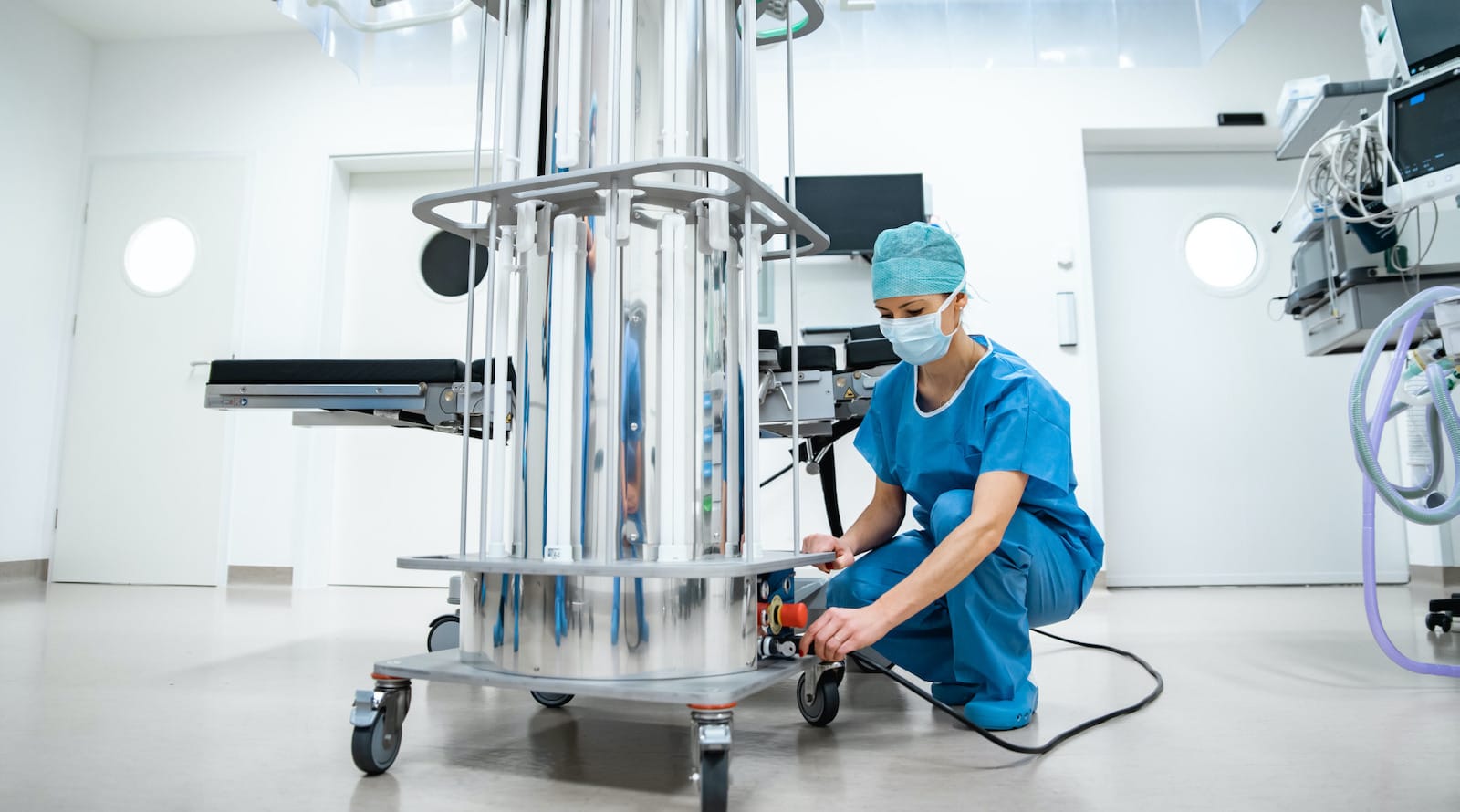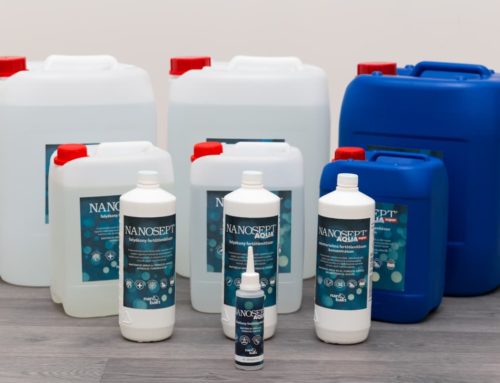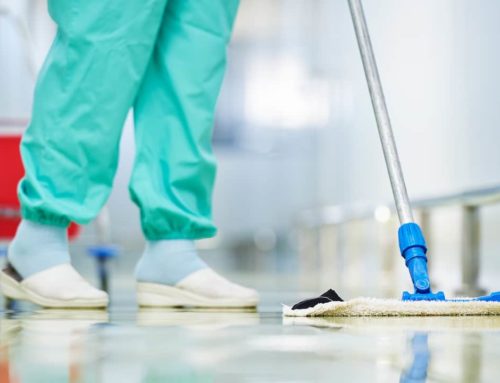Introduction
Healthcare associated infection (hereafter referred to as infection) is a major cause of morbidity and mortality worldwide. According to the results of a point prevalence study conducted by the European Centre for Disease Prevention and Control (ECDC) between 2016 and 2017, 5.9 % of patients in health care institutions and 3.7 % in residential social care institutions were infected, mainly by respiratory infections (1). The most commonly isolated microorganisms were Escherichia coli, Staphylococcus aureus, Klebsiella spp., Enterococcus spp., Pseudomonas aeruginosa and Clostridium difficile (1).
Numerous studies show that these, as well as other specific and non-specific pathogens, often contaminate the environment, including both porous (e.g. curtains, bedding) and non-porous surfaces (e.g. beds, medical devices) (2). In health and social care institutions, disinfection of the environment is a fundamental task of infection control programs. However, the effectiveness of conventional disinfection procedures is adversely affected by a number of factors (e.g. small and/or untrained cleaning staff, unspecified levels of responsibility, type of surface to be disinfected, inappropriate use of disinfectants) (3-7). In addition, these methods do not always remove pathogens (e.g. Clostridium difficile, methicillin-resistant Staphylococcus aureus, vancomycin-resistant Enterococcus, multidrug-resistant Acinetobacter baumannii) (8-12). Experts are therefore increasingly emphasizing the need for innovative drugs and solutions (e.g. nanosilver, ozone, ultraviolet-C light, cold fog) (2, 13-14).
Silver has been a precious metal known for thousands of years. Initially it was used to keep and preserve liquids and food, later it was used as a raw material for dishes, jewelery and coins, but nowadays it is also widely used for other purposes (e.g. bandages and medical device components, biodiagnostics, immune system strengthening, antiviral therapy) (15-16). In addition, silver has a significant disinfectant effect. Colloidal silver particles (nanosilver) are able to destroy microorganisms (such as SARS-CoV-2, multidrug-resistant Acinetobacter baumannii, Staphylococcus aureus, Pseudomonas aeruginosa, Escherichia coli) rapidly, efficiently and persistently due to the active oxidation-reduction chemical reaction.
Another advantage is that pathogens do not become resistant to silver, it does not damage treated surfaces (e.g. electrical medical devices, air conditioners) and does not produce toxic by-products harmful to human health, therefore it is safe and environmentally friendly. (20-22). To enhance its antimicrobial effect, it is used in a solution of hydrogen peroxide in new generation disinfectants. As a result, active (nascent) oxygen is released from the hydrogen peroxide after application to the surface, which destroys all organic components as an aggressive solvent, thus immediately and effectively destroying pathogens, and on the other hand, the silver particles remaining from the solution dry for a long time have an antimicrobial effect lasting up to 1 day (23).
Despite the long-standing use of hydrogen peroxide as an environmental disinfectant in health and social care institutions, its combined use with nanosilver is even less common. The purpose of this article is to provide an overview of the scientific evidence on the efficacy of nanosilver and hydrogen peroxide-containing disinfectants.
Method
A systematic literature search for the purpose of this review was conducted under the Preferred Reporting Items for Systematic Reviews and Meta-Analyzes (PRISMA) guideline (24). Subject to the requirements of appropriate interpretability, only the full English-language relevant literature articles and gray publications published between 1 January 2010 and 31 March 2020 are available from the Cochrane Library, the Cumulative Index to Nursing and Allied Health Literature. (CINAHL), the Database of Abstracts of Reviews of Effects (DARE), the Excerpta Medica database (EMBASE), the Health Technology Assessment (HTA) database, the Medical Literature Analysis and Retrieval System Online (MEDLINE), the Medicines and Healthcare products Regulatory Agency (MHRA) database, National Patient Safety Agency (NPSA) database, National Institute for Health and Care Excellence (NICE) database, ScienceDirect databases. The search was performed using regulated [Medical Subject Headings (MeSH) and EMBASE Subject headings (Emtree)] and natural vocabulary (keywords), “silver”, “hydrogen peroxide” and “disinfection”, and “health and social care institutions”. The results were placed in an EndNote library, where, after the duplicates were automatically removed, a review was performed manually, followed by a review of the titles, abstracts, and publications relevant to the study objective. The literature search was supplemented with a review of the bibliography of relevant articles and related publications in the databases.
Results
A total of 132 titles and abstracts were examined during the literature search. Of these, 36 appeared potentially relevant, the full text of which was evaluated. Finally, eight communications met the criteria.
A randomized, multi-centred study was performed in the wards of an Italian hospital to compare the effectiveness of manual disinfection with a cold fogging machine containing silver and hydrogen peroxide and a solution of sodium hypochlorite (26). The purpose of the culture performed before and after disinfection was to quantify the number of spores and to qualitatively detect Clostridium difficile. Prior to disinfection, large numbers of Clostridium difficile spores were detected on the surfaces to be treated. After cold fogging with silver and hydrogen peroxide, no marker bacteria were cultured, in contrast to manual disinfection with sodium hypochlorite solution. Although the difference between the two groups was not statistically significant, the researchers recommend disinfection with a cold misting machine containing silver and hydrogen peroxide because its effectiveness is not person-dependent.
A microbiological study carried out at an Italian university hospital showed that Nanosilver and hydrogen peroxide disinfectants applied to clean and contaminated surfaces reduced Staphylococcus aureus and Pseudomonas aeruginosa after 10 minutes and significantly reduced the resistance of multidrug-resistant pathogens after 15 minutes (25).
Following the discharge of two patients with sepsis caused by multidrug-resistant Acinetobacter baumannii in the burn department of a Portuguese hospital, disinfection was performed with an automatic cold fog machine containing nanosilver and hydrogen peroxide-containing agents. No Acinetobacter baumannii was cultured from the surface samples after the intervention (18).
Following the disinfection of air conditioners with nanosilver and hydrogen peroxide aerosols in the surgical and intensive care units of two Italian hospitals, the presence of Aspergillus fumigatus and other filamentous fungi were eliminated on the basis of microbiological examination of surface and air samples taken from sampling points near the equipment.
An intensive care unit in a hospital in Saudi Arabia conducted a three-year intervention study using nano-silver and hydrogen peroxide cold misting, three-hour disinfection, and isolation boxes to reduce the incidence of healthcare-associated infections (28). Efficacy was assessed by microbiological examination of samples taken from patients and from the most commonly affected surfaces of examiners, corridors, and boxes before and after disinfection. By the end of the program, despite the relapses due to the depletion of the hydrogen peroxide cartridge, Acinetobacter spp., E. coli, Staphylococcus ssp. The rate of infections was reduced from 14.3% to 4%.
The wards and air-conditioning facilities of the wards of an Indian university hospital were disinfected with a cold mist generator filled with a solution containing silver and hydrogen peroxide. Based on the results of microbiological cultivation before and after the intervention, this innovative active ingredient and method effectively and quickly disinfected the air, furniture and other objects in the premises (29).
The inactivating effect of silver and hydrogen peroxide-containing disinfectants on pathogenic enterobacteria (Escherichia coli, Proteus mirabilis and Klebsiella pneumoniae) has been studied on steel surfaces in an Iranian university hospital (30). Qualitative microbiological examination of surface contamination showed that three marker bacteria were significantly inactivated after 15 min of exposure to the disinfectant.
Discussion
There is “A” level of evidence that air and surface disinfection with adequate frequency and effectiveness has a positive effect on the incidence of infections in health and social care institutions (31 – 33).
However, the effectiveness of manual disinfection with conventional disinfectants, which is still common today, is inadequate in most cases. In addition to institutional and personal problems, this is affected by the lack of antimicrobial activity of certain disinfectants against pathogens (e.g. chlorhexidine, trichloroisocyanuric acid and povidone iodine vs. carbapenem-resistant Enterobacteriaceae strains; quaternary ammonium vs. Klebsiella cuminidium Klebsiella pneumoniae, Pseudomonas aeruginosa, and Acinetobacter baumannii) (34 – 36).
The use of improved but even less common silver and hydrogen peroxide-containing combined disinfectants with a cold misting machine (“non-contact”) is an effective alternative to currently widely used disinfectants and methods (eg manual disinfection with sodium hypochlorite solution) (37). This is confirmed by all the in vitro and in situ test results we reviewed (7, 25–30).
However, its use more widely, in addition to traditional and disinfection practices, requires further research as publications have used different methods and pathogens in conducting efficacy studies.
Conclusions
The results described in the publications meeting the research criteria support the ability to rapidly, efficiently, and permanently inactivate nosocomial pathogens using new-generation nanosilver and hydrogen peroxide-containing disinfectants. Given the increasing prevalence of multi-resistant pathogens in health and social care institutions and the fact that adequate environmental disinfection is not always achieved for the reasons set out in the introduction, a much more (cost-effective) innovative than traditional one should be considered, the use of nanotechnology-based disinfectants and automated technologies (eg cold mist formation). It is the responsibility of the institution’s management to implement disinfectants and disinfection methods as part of the infection control program to prevent and reduce the incidence of infections, taking into account recommendations based on scientific evidence.
Acknowledgments
The authors thank Judit Korom, a hygienist at the National Institute of Clinical Neuroscience, for her professional support.
Bibliography:
[1] Suetens C, Latour K, Kärki T, et al. Prevalence of healthcare-associated infections, estimated incidence and composite antimicrobial resistance index in acute care hospitals and long-term care facilities: results from two European point prevalence surveys, 2016 to 2017. Euro Surveill. 2018;23: pii=1800516.
[2] Han JH, Sullivan N, Leas BF, et al. Cleaning hospital room surfaces to prevent health care-associated infections. a technical brief. Ann Intern Med. 2015;163: 598-607.
[3] Carling PC, Bartley JM. Evaluating hygienic cleaning in health care settings: what you do not know can harm your patients. Am J Infect Control. 2010;38: S41–50.
[4] Anderson RE, Young V, Stewart M, et al. Cleanliness audit of clinical surfaces and equipment: who cleans what? J Hosp Infect. 2011;78: 178–181.
[5] Ali S, Moore G, Wilson AP. Effect of surface coating and finish upon the cleanability of bed rails and the spread of Staphylococcus aureus. J Hosp Infect. 2012;80: 192–198.
[6] Cadnum JL, Hurless KN, Kundrapu S, et al. Transfer of Clostridium difficile spores by nonsporicidal wipes and improperly used hypochlorite wipes: practice + product = perfection. Infect Control Hosp Epidemiol. 2013;34: 441–442.
[7] Ramm L, Siani H, Wesgate R, et al. Pathogen transfer and high variability in pathogen removal by detergent wipes. Am J Infect Control. 2015;43: 724–728.
[8] Sigler V, Hensley S. Persistence of mixed staphylococci assemblages following disinfection of hospital room surfaces. J Hosp Infect. 2013;83: 253–256.
[9] Manian FA, Griesnauer S, Senkel D. Impact of terminal cleaning and disinfection on isolation of Acinetobacter baumannii complex from inanimate surfaces of hospital rooms by quantitative and qualitative methods. Am J Infect Control. 2013;41: 384–385.
[10] Hayden MK, Bonten MJ, Blom DW, et al. Reduction in acquisition of vancomycin-resistant Enterococcus after enforcement of routine environmental cleaning measures. Clin Infect Dis. 2006;42: 1552–1560.
[11] Eckstein BC, Adams DA, Eckstein EC, et al. Reduction of Clostridium difficile and vancomycin-resistant Enterococcus contamination of environmental surfaces after an intervention to improve cleaning methods. BMC Infect Dis. 2007;7: 61.
[12] Mitchell BG, Dancer SJ, Anderson M, et al. Risk of organism acquisition from prior room occupants: a systematic review and meta-analysis. J Hosp Infect. 2015;91: 211–217.
[13] Rutala WA, Weber DJ. Disinfectants used for environmental disinfection and new room decontamination technology. Am J Infect Control. 2013;41: S36–41.
[14] Donskey CJ. Does improving surface cleaning and disinfection reduce health care-associated infections? Am J Infect Control. 2013;41: S12–19.
[15] Ge L, Li Q, Wang M, et al. Nanosilver particles in medical applications: synthesis, performance, and toxicity. Int J Nanomed. 2014;16: 2399-2407.
[16] Deshmukh SP, Patil SM, Mullani SB, et al. Silver nanoparticles as an effective disinfectant: a review. Mater Sci Eng C. 2018;97: 954-965.
[17] Cobrado L, Pinto Silva A, Pina-Vaz C, et al. Effective Disinfection of a Burn Unit after Two Cases of Sepsis Caused by Multi-Drug-Resistant Acinetobacter baumannii. Surg Infect (Larchmt). 2018;19: 541-543.
[18] Eleraky NE, Allam A, Hassan SB, et al. Nanomedicine Fight against Antibacterial Resistance: An Overview of the Recent Pharmaceutical Innovations. Pharmaceutics. 2020;12: 142.
[19] Pelgrift RY, Friedman AJ. Nanotechnology as a therapeutic tool to combat microbial resistance. Adv Drug Deliv Rev. 2013;65: 1803-1815.
[20] SCENIHR (Scientific Committee on Emerging and Newly Identified Health Risks), Risk assessment of products of nanotechnologies. http://citeseerx.ist.psu.edu/viewdoc/summary?
[21] Slawson RM, Van Dyke IM, Jack HL, et al. Germanium and silver resistance, accumulation, and toxicity in microorganisms. Plasmid. 1992;27: 72-79.
[22] Dancer SJ. Controlling hospital-acquired infection: focus on the role of the environment and new technologies for decontamination. Clin Microbiol Rev. 2014;27: 665-690.
[23] Moher D, Liberati A, Tetzlaff J, et al. Preferred Reporting Items for Systematic Reviews and Meta-Analyses: The PRISMA Statement. PLoS. Med. 2009;6: e100097.
[24] De Giglio O, Coretti C, Lovero G, et al. Pilot study on the antibacterial activity of hydrogen peroxide and silver ions in the hospital environment. Ann Ig. 2014;26: 181-185.
[25] Mosci D, Marmo GW, Sciolino L, et al. Automatic environmental disinfection with hydrogen peroxide and silver ions versus manual environmental disinfection with sodium hypochlorite: a multicentre randomized before-and-after trial. J Hosp Infect. 2017;97: 175-179.
[26] Totaro M, Costa AL, Casini B, et al. Microbiological Air Quality in Heating, Ventilation and Air Conditioning Systems of Surgical and Intensive Care Areas: The Application of a Disinfection Procedure for Dehumidification Devices. Pathogens. 2019;8: 8.
[27] Al Bshabshe A, Joseph MRP, Assiri A, et al. A multimodality approach to decreasing ICU infections by hydrogen peroxide, silver cations, and compartmentalization. J Infect Public Health. 2020;pii: S1876-0341(20)30366-X.
[28] Taneja N, Biswal M, Kumar A, et al. Hydrogen peroxide vapour for decontaminating air-conditioning ducts and rooms of an emergency complex in northern India: time to move on. J Hosp Infect. 2011;78: 200-203.
[29] Davoudi M, Ehrampoush MH, Vakili T, et al. Antibacterial effects of hydrogen peroxide and silver composition on selected pathogenic enterobacteriaceae. Int J Env Health Eng. 2012;1: 23.
[30] Siani H, Maillard JY. Best practice in healthcare environment decontamination. Eur J Clin Microbiol Infect Dis. 2015;34: 1-11.
[31] Donskey CJ. Does improving surface cleaning and disinfection reduce health care-associated infections? Am J Infect Control. 2013;41: 13-19.
[32] Kramer A, Schwebke I, Kampf G. How long do nosocomial pathogens persist on inanimate surfaces? A systematic review. BMC Infect Dis. 2006;6: 130.
[33] Chen Y, Liao K, Huang Y, et al. Determining the susceptibility of carbapenem resistant Klebsiella pneumoniae and Escherichia coli strains against common disinfectants at a tertiary hospital in China. BMC Infect Dis. 2020;20: 88.
[34] Azadpour M, Nowroozi J, Goudarzi GR, et al. Presence of qacEΔ1 and cepA genes and susceptibility to a hospital biocide in clinical isolates of Klebsiella pneumoniae in Iran. Trop Biomed. 2015;32: 109-115.
[35] Vijayakumar R, Sandle T, Al-Aboody MS, et al. Distribution of biocide resistant genes and biocides susceptibility in multidrug-resistant Klebsiella pneumoniae, Pseudomonas aeruginosa and Acinetobacter baumannii – A first report from the Kingdom of Saudi Arabia. J Infect Public Health. 2018;11: 812-816.
[36] Boyce JM. Modern technologies for improving cleaning and disinfection of environmental surfaces in hospitals. Antimicrob Resist Infect Control. 2016;5: 10.
Authors:
Rita Szabó MSc, MBA, PhD epidemiologist
István Barcs PhD clinical and epidemiological microbiologist, ret. head of department, college teacher



